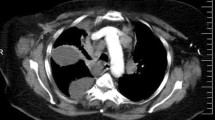Summary
57 patients were divided into two groups at random. The patients of two groups were all given standard treatments with anti-tuberculous drugs. Treatment group received artificial pneumothorax to help the cure. Results showed that the frequency and quantity of drawing liquid in the treatment group were obviously less than those in the control group and the duration of the complete liquid absorption was shortened markedly in the treatment group and that total effective rate in treatment group (92. 5 %) was obviously higher than that of the control group (83. 33 %). We found that the artificial pneumothorax could raise the intra-pleural pressure by 0. 20–0. 39 kPa, reduce leakage in parietal pleurae and increase the absorption in visceral layer evidently. As it can isolate the two layers of pleurae from one another by the air in thorax, the incidence of pleurae adhesion can be decreased.
Similar content being viewed by others
References
Wit D, Maartens G, Steyn Let al. A comparative study of the polymeras chain reaction adn conventional procedures for the diagnosis of tuberculous pleural effusion. Tuber Lung Dis, 1992, 73: 262
1993, 16(5): 290
Author information
Authors and Affiliations
Rights and permissions
About this article
Cite this article
Huiping, L., Yun, L. Treatment of tuberculous pleurisy with effusion by artificial pneumothorax. Journal of Tongji Medical University 16, 52–54 (1996). https://doi.org/10.1007/BF02889046
Received:
Issue Date:
DOI: https://doi.org/10.1007/BF02889046




